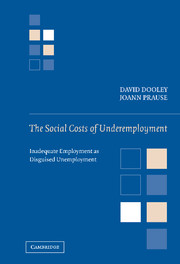Book contents
- Frontmatter
- Contents
- Preface
- 1 Disguised Unemployment and Changing Forms of Work
- 2 The Social Costs of Unemployment
- 3 Data Sources and Methods
- 4 Reverse Causation: Findings on the Selection Hypothesis
- 5 Leaving School: Self-esteem in an Unwelcoming Economy
- 6 Early Adulthood: Alcohol Misuse and Underemployment
- 7 Settling Down: Psychological Depression and Underemployment
- 8 Extending the Employment Continuum: Well-Being in Welfare Transitions
- 9 The Next Generation: Underemployment and Birthweight
- 10 Conclusions
- 11 New Directions
- Appendix A
- Appendix B
- References
- Name Index
- Subject Index
3 - Data Sources and Methods
Published online by Cambridge University Press: 27 July 2009
- Frontmatter
- Contents
- Preface
- 1 Disguised Unemployment and Changing Forms of Work
- 2 The Social Costs of Unemployment
- 3 Data Sources and Methods
- 4 Reverse Causation: Findings on the Selection Hypothesis
- 5 Leaving School: Self-esteem in an Unwelcoming Economy
- 6 Early Adulthood: Alcohol Misuse and Underemployment
- 7 Settling Down: Psychological Depression and Underemployment
- 8 Extending the Employment Continuum: Well-Being in Welfare Transitions
- 9 The Next Generation: Underemployment and Birthweight
- 10 Conclusions
- 11 New Directions
- Appendix A
- Appendix B
- References
- Name Index
- Subject Index
Summary
Unemployment and mental health researchers have frequently proceeded by contrasting the better mean mental health of employed people with the worse mean mental health of unemployed people in both cross-sectional and longitudinal designs. However, it may now be only a matter of time until the deteriorating mean mental health of employed people obliterates this formerly largely reliable difference.
Fryer, 1999, p. 1INTRODUCTION
Overview
Longitudinal Designs. This chapter will describe the longitudinal research design, the data sources, and the key measures used throughout this book. In contrast to cross-sectional designs, which measure all subjects at a single point in time, longitudinal research includes a variety of different designs, each having differently timed measurement periods as a common component. Longitudinal approaches that assess a different group of individuals at each point in time are called “trend” designs. In contrast, a “panel” design measures the same individuals at multiple points in time (for further details on such designs, see Babbi, 1995; Bijleveld et al., 1998; Kleinbaum, Kupper, & Morgenstern, 1982; Menard, 1991). All of our analyses employ panel designs.
Panel designs are particularly useful because they characterize change over time within individuals (intraindividual change) as well as between individuals (interindividual change). Clarification of the temporal sequence of events is central to the study of complex causal relationships between variables. Experimental research designs deal with this problem by arranging for the presumed cause (a manipulated independent variable) to take place before the presumed effect.
Information
- Type
- Chapter
- Information
- The Social Costs of UnderemploymentInadequate Employment as Disguised Unemployment, pp. 36 - 64Publisher: Cambridge University PressPrint publication year: 2003
